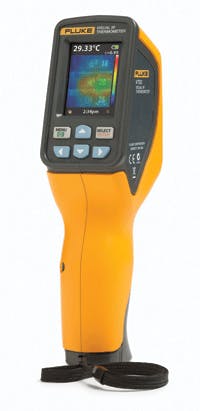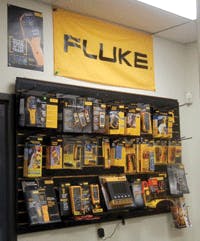Fluke literally sets the standard when it comes to test tools. Fluke employs the world standard for the DC volt and builds more than 90 percent of the electrical calibrators used in the United States, which means that if a handheld electrical test tool has been calibrated in the United States, there’s a very good chance its accuracy is traceable back to national standards through Fluke calibrators.
Most people know Fluke for their electrical measurement tools. Few people know that Fluke makes field calibration tools, which are used to verify the accuracy of in-field sensors. On the industrial side, Fluke field calibration tools are used to check the accuracy of sensors and gauges that measure how hot, cold, quickly or slowly something is being processed. In HVACR, Fluke tools are used to commission, troubleshoot and rebalance ventilation, heating and cooling systems. The most complicated Fluke HVACR tools are “air meters” that measure everything from CO2 to outside air calculations at a high degree of accuracy, while other models provide simpler, more focused pressure, temperature and humidity measurements.
“HVACR contractors use Fluke products for everything from measuring airflow, checking connections and looking for breaks in radiant floor heating,” says Mark Carter, Fluke national accounts manager.
HVACR troubleshooting across all lines of business – residential, commercial, industrial – is in Fluke’s sweet spot, adds Brian Stowell, Fluke North American marketing and field sales manager. “Any type of troubleshooting when it comes to flue temperatures, flue ignition temperatures, we’ve got lots of products that measure airflow,” he says. Refrigeration, too, is a big part of Fluke’s business.Ease of Use
To develop these world-class tools, Fluke engineers spend a lot of time examining exactly how their customers use their devices. “We put a lot of effort into making our products very simple to use,” says Carter. “We don’t necessarily load our products with a ton of features that no one will need. Ease of use along with ruggedness and reliability are core to our brand promise.”
Coming up with an instrument that turns out to be exactly what an HVACR professional needs requires spending a lot of time in the field. “I’ve been up on roofs with HVAC technicians and out in the cold with electrical contractors,” Stowell says.
“We don’t design something unless we have at least 100 to 200 points of data from end users,” Stowell says. “We need to know everything, from what features technicians want in the field to seeing how they hold the product or what they do with the product to make sure it meets their requirements. A big thing we work on is ergonomics. We have an industrial design group that focuses specifically on that.”
“We also recognize that time is money to our customers,” Carter adds. “HVACR technicians need to know that when they go out on a job, even if they’ve dropped the tool off a ladder recently, that it’s going to work for them. We put a lot of emphasis on durability and the reliability of our products.”
During a recent series of focus groups Fluke held with distributors’ salespeople, they were asked what separates Fluke from competitors. Their answer, Stowell says, was simple and clear: “Because it will work every time you need it to.”
Fluke also stays close to its end user customers at trade shows and industry events. This gives contractors a platform to ask questions and offer suggestions about Fluke equipment. Carter says HVACR contractors who attend these events are highly skilled and have an appetite to learn more about the trends in the industry. To Carter, it shows that contractors are keeping pace with the rapid changes in HVACR, particularly as they relate to building automation.
It also demonstrates their desire to find new business opportunities in the areas in which Fluke specializes. “They have service contracts and they’re really expanding their business model to quickly take advantage of building controls and automation, which naturally leads to energy management,” Carter says. Like their contractor customers, Fluke too is more focused on energy management and controls troubleshooting. “That’s where the market is headed,” he says.
Training and Communication
Fluke’s market research extends to how it can better sell its products through distribution. Fluke tools are sold through wholesalers. To enhance its relationship with its wholesale distributors, Fluke employs a multipronged approach to train and communicate with them as well as their customers.
Fluke’s field sales engineers and regional distribution managers as well as a technical support line (1-800-44-Fluke) are available to answer distributor and customer questions. Its network of manufacturer representatives enhances this support, providing ongoing updates and information to wholesalers – whether in person, by phone or through email or texts. Through this ongoing support in the field, the Fluke sales team learns what works and what doesn’t for distributors and shares this information across its network.
Popular features to keep distributors apprised of what’s happening with Fluke are its bimonthly newsletter and quarterly webinars. “It allows them to interact with our team so we make sure we’re giving our customers accurate support,” Stowell says of the webinars.
Fluke also collaborates with its distributors on ways to bring contractors into branches. Promotions – both in-store and online – are designed to highlight both the Fluke brand and the distributor. Most Fluke promotions and programs include enough training so that salespeople know exactly how Fluke products will help their customers save time and money. “We do everything to make sure it’s a win-win across the board, not only for the distributor but for the distributor’s salesperson,” Stowell says.
What’s new?
One of the most exciting new products in the Fluke brand family is the VT02 Visual IR Thermometer. For the past eight years, Fluke had sold a thermal imager, also known as an infrared camera, that provides a thermal image of an object, showing exactly what kind of heat is being put out. For HVAC technicians, a thermal imager can be used to detect heat patterns or temperature changes in HVAC equipment. However, the entry-level price point for a Fluke thermal imager is around $2,000.
“Ever since we put these tools out, the HVACR market has been asking for a more price-sensitive model,” Carter says. That’s where the VT02 comes in. The new VT02 Visual IR Thermometer bridges the gap between low-cost IR thermometers and higher priced thermal imagers. It allows HVAC users to see what they are measuring with a digital image that can be blended with a thermal heat map in 25 percent increments to help uncover hot and cold spots with more detail and greater speed than a traditional spot thermometer.
“The groundbreaking price point of the VT02 gives the HVAC industry a new option that is far more efficient than traditional spot thermometers in finding hot spots,” Carter says.
And now, he says, the HVACR market is going crazy for the VT02. “We introduced it about five months ago, and for the first time, HVACR technicians are getting a tool in their price range that gives them a heat map of the equipment they’re working on, and they’re loving it.”
Fluke wants to continue to expand their offerings for the HVACR customer. “We want to make sure that our wholesalers have the tools they need to effectively sell our products and to present them to customers in a way that customers will recognize the benefits quickly and easily,” Carter says.
For the past 65 years, Fluke calibration products have helped define a unique technology market. As technology expands and the HVACR industry becomes more demanding, Fluke will be listening, taking notes and continuing to design market-leading instruments.
“We’re always looking for different ways to improve productivity and improve the ability to do the job fast the first time around,” Stowell says. “With the amount of time we spend in the field with HVACR customers, I think we’ll continue to find more opportunities for new tools.”
Best Practice
Fluke best practices to support sales at HVAC Distributors
- When we do a promotion, we try to make it multifaceted – include something in it for the distributor salespeople, our reps and our end customer. Several times a year, Fluke runs a central promotion that ties in opportunities for distributor staff to earn or win prizes and/or cash. Other offers include discounts off of net price, changes in payment terms, free shipping, buy one get one and so forth.
-
We put a lot of emphasis on merchandising concepts and displays. We use merchandising audits as a way to make sure our reps regularly visit branch locations and as a tool to make sure they're looking for opportunities to improve displays, verify that promotions are visible and ensure that we get the right products in front of customers at the branch levels. Since Fluke products are specifically designed for distinct types of end users and applications, it's all about fitting the right product and merchandising display to the right branch.
Being Fluke (the mindset of accurate, repeatable measurement transfers over to consistent, results-oriented work practices), we not only study our customers' measurement needs and practices, we also study our own internal processes and document best practices,with the goal of creating ways to communicate and leverage the most successful methods into the rest of the field – good/better/best, eye level, secondary displays, etc. We're constantly gathering information on what works, by having our reps report back on consistent factors, and then our merchandising experts at the HQ level can provide feedback and guidance on what could be improved.
Lastly, for years now we have produced a combination merchandising catalog/training manual for distributors with best practices and examples of merchandising to demonstrate what works and why. Combined with our online distributor intranet, we do our best to deliver information on Fluke products, promotions and merchandising opportunities. -
It's important that we develop a good, working relationship with our distributors, specific to each of the various levels of their organization.Franchise: It's important to work at three levels – corporate for website and national promos; at ownership group level to get their buy-in for in-store activities and with in-store staff, for training and merchandising coordination.National models: Still work at all three levels – and for each distributor, we build the relationship where it makes the most sense based on how their organization is set up.While the majority of our programs are developed through direct work between Fluke account managers and our distributor partners, we also offer on-demand and scheduled product and application training for distributor staff.
-
Product: What is it about Fluke products that works really well in the store, beyond all of the support we provide?
- Increasingly price-sensitive offerings that deliver Fluke quality and high technology in different formats better suited for HVAC applications – overall higher value proposition for customer – Visual Thermometers and smaller thermal imagers being the latest and most popular (and best-selling!) example of this.
- HVAC-specific products.
- Efficiency through technology – distance meter.
- For electrical – Customers see Fluke as the most reliable tool brand out there. When they pick it up, it is going to work. Combined with that, safety. If they do the wrong thing, it could be lethal if their tool isn't safety rated for their electrical environment.
- Fast growing sectors/New business opportunities – vibration/reliability, building controls, energy management – Fluke’s tools are the easiest to use and are designed specifically for service work.
Kate Kelly is an associate editor at Contracting Business. Contact her at 216/931-9755 or [email protected].












